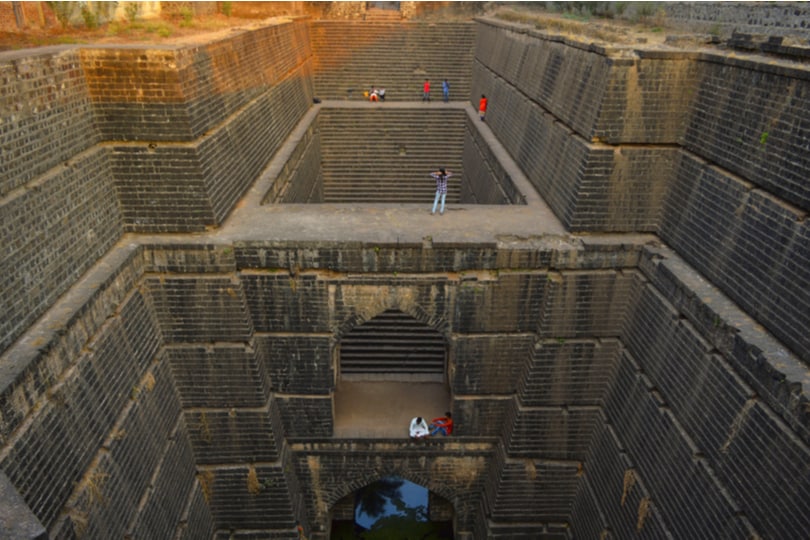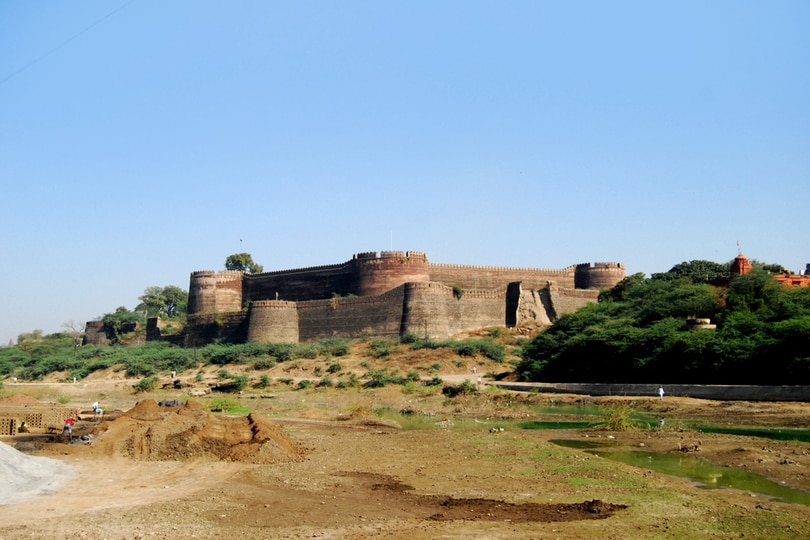A well-known vista of Sahyadri Range, Satara is a suburban city in the state of Maharashtra. It has had a pivotal influence on the history of the Maratha Empire that governed in the 17th century. The plateau and its surroundings brace the palatial Forts in Satara. The forts are symbolic of the successes of Shivaji Maharaja’s descendants and Bhosle Clan’s supremacy. The acropolises tell the tales of the people, the city, and the sentiment that flows throughout. The archeological sites are not just for history fanatics, but also adrenaline zealots to explore. Satara is a thriving destination for tourists looking for adventure and recreation.

Heritage rich and legendary, the city of Satara once was an abode of the Maratha Kingdom. The folklore echoes the story of great warriors, rulers, and saints that changed the fate of Maharashtra. Before it came under the rule of King Chhatrapati Shivaji, Satara’s landscape had hills blanketed with dense forests. It allowed Shivaji to build a total of twenty-five forts and administration units in and around the city. These superstructures became acclaimed for their architectural brilliance and strategic placements. They are a testimony of the immortal grandeur of the Forts in Satara.
Amongst many historic structures, there are five principal Forts in Satara that you can explore. The ruins of these castles are sacred to people, for it is a symbol of high power and a proud clan of warriors.
Have you come across the account of the Battle of Pratapgad? It was the clash between Shivaji Maharaj and the Mughal Emperor Afzal Khan at the lower barricade of the fort in 1656. The battle entrenched the fierce dynamism of the Maratha Empire. In 1818, Pratapgad fort was surrendered to the Britishers after the Third Anglo-Maratha War. It is one of the most visited forts across the country as well as the state and can be approached by a designated and functional road. Pratpagad is popular amongst tourists seeking adventure. There are hiking trails around the fort, through which you can ascend, descend, and go around. Upon reaching, you will find that the keela (fortress) segregates in two- upper fort and lower fort. The high fort is on the cliff of the hill that looks upon the village settlements, patches of forests, farms, the valley. The scenic view will awaken the photographer in you.
The hill fort dates back to the prehistoric era. Constructed by the Dynasty of Yadavas at around 1210 – 1247 CE, you can see a few structural differences in this keela as compared to others. The oval and flat-topped architecture was fortified by Shivaji in the mid-1600s. Inside the fort, there are two temples, one of Maruti and the other of Harini Devi. The temple of Harini Devi, who is an incarnation of Goddess Durga is the only temple of the goddess with vast lands of the plateau surrounding it. You can set up camp on these open lands with the view of the Bhushangad Fort. You can also go trekking to scout around the property of the fort. The Bhushangad keela is an ideal spot for those who wish for a memorable camping experience. You can have a camp under the stars, light a campfire, and immerse yourself in the impassive and untouched nature. The spiritual, the adventurous, or both must visit the Fort of Bhushangad to gain blessings from mother nature and God.
Kamalgad Fort (Lotus Fort), is known by many names. Widely known as Bhelenja or Katalgad, it translates to ‘Fort of Death’. The fort is said to acquire this name during the British Rule, as it is where the colonizers used to crucify their prisoners during the freedom struggle. In 1818, Kamalgad, rather then Katalgad, was under the command of Royal officer, Major Thatcher. As dark and gruesome as that sounds, the fort has a splendid view of the forest around that will leave you awestruck. It has tourists visiting it all year round to see its unique placement. At an elevation of 4511 feet, Kamalgad covers about 5 acres of the tabletop. It is fenced with steep boulders and solid rocks. There is a now blocked tunnel route to the fort that was built by the Britishers. However, you will find it closed due to a fallen boulder in the tunnel. You can approach the fort through designated tracks. Once there, you will find intriguing structures and rock piles that will make your imagination run wild. The beauty of this fort lies in the panoramic view of Panchgani and Mahabaleshwar plateau, the blue river, and a thick spread of trees.
Sajjangad is a place of pilgrimage as it is the necropolis of Saint Ramdas. Sajjangad translates to a Fort of Good Men. It was once known as Aswalyagad as there were families of bears (Aswals) that lived in its vicinity. The fort saw constant switching between the reign of Mughals and Marathas. The fight over its ownership ended after Sajjangad came under the administration of the Britishers in 1818. Having a conflicted history, Sajjnagad remains as a sanctuary for devotees of Saint Ramdas. You can attend the prayer session and take prasad and blessings from the priest. The fort is approachable by vehicle up to a certain point on the hill. There onwards, there are about two hundred odd steps you need to climb to arrive at the entrance. It could be the ultimate hike if you embark on an on-foot journey from the beginning itself. Sajjangad will gratify your need for adventure, history, and spirituality.
At 3,300 feet, Ajinkyatara translates to an unconquerable star. It was built using lead and stone, making it one of the sturdiest structures of its time. It is an architectural wonder and heritage fort of the Marathas. During the reign of Aurangzeb, the fort was known as Ajimtara, dubbed after his son, Ajim. The fortress was built in 1150 under the rule of Raja Bhog II. Ajinkyatara too fell in the hands of Britishers in 1818, who stationed Pratapsingh as a marionette ruler. The fort plays an important role in the history of Marathas. It played host to many fights and conflicts from the time of the Mughal rule to British Rule in India. Once there, you can pay a visit to the Hanuman Temple, Mahadev Temple, and Mangaladevi Temple. You must observe the bastions that made the fort unyielding and impregnable. While exploring Ajinkyatara, you can witness the magnificent lakes that lay dotted here. The keela gives a birdseye view of Satara and the Sahyadri ranges.

When it comes to lodging and boarding, you will be spoilt for choices in Satara. You will find options from luxury hotels to simple BnBs. The closer tourist attractions are, the higher the number of hostelries. Resorts and retreats are mostly on the outskirts of the city, letting you escape the hustle-bustle. If you wish to experience city life, then there are several options and types of rooms to choose from. The price range of accommodations in Satara is quite reasonable as per the kind of lodging you choose.
Satara is famous for its kandi peda, which is a soft sweet treat made from milk and sugar, flavored with cardamom or saffron. The cuisine here is decadent, vibrant, and flavourful. You can find these dishes in restaurants as well as in the form of street food. Bear in mind that the food here is on the spicier side. You will find delicious, aromatic vegetarian curries of local produce to feist on with bhakris. A typical dish of the region is mutton-bhakri — the delightful mutton curry made with robust spices and flavors accompanied by piping hot bhakris.
Satara and the rest of Maharashtra celebrate their New Year’s with Gudi Padwa. They welcome the new beginning and year with prayers and sweets. Ganesh Chaturti is widely and wildly celebrated. It is the ceremony of gratitude and respect for Lord Ganesha. It is celebrated with modaks, music, and devotion. Makar Sankranti is a festivity where the community comes together to rejoice with food and fun. People come together and fly kites, as it marks the end of winters.

Satara has a well structured and fully functional commute system within and around the city.
By Air: Pune International Airport in Lohegaon, Pune is the nearest airport. It is 120 km away. Mumbai Airport (Chhatrapati Shivaji International Airport) is 256 km away.
By Rail: The Satara Railway Station falls on the Pune-Miraj line. The Station has connections to other cities in the state of Maharashtra, as well as the country, through express passenger trains.
By Road: Buses in Satara are efficient options for people coming from neighboring cities like Pune and Mumbai. There are public and private buses that run every ten minutes to Satara.
Forts in Satara are nirvana-esque for travelers enthusiastic about photography. Using cameras and mobile phones are allowed in all tourist spots. However, some places may ask for a small fee for usage.
The Forts in Satara are historical relics that recite the tales of the Marathas. The ruins of these citadels have archeological importance and are architecturally brilliant. It’s the ultimate destination for those who love history, adventure, and are looking for a gateway from the bustling cities. You will get to experience the enthralling history, the great wonders, and the breathtaking surroundings of the Sahyadri Ranges.

Please go back to portrait mode for the best experience